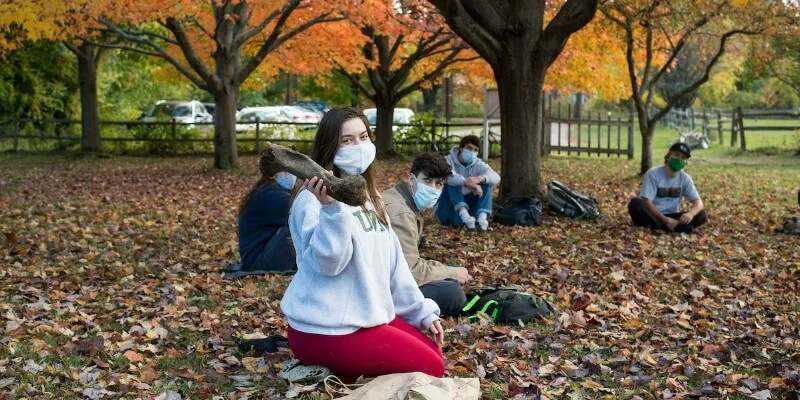It was a hefty bovine femur bone, long and pitted and heavy in her hands, that sparked the whimsical tale Marina Dardati ’20 and her classmates would weave for the fourth and fifth graders at Flynn Elementary School. Pandemic restrictions in place, the popular Birding to Change the World class and its service-learning project — a robust five-year partnership between UVM and Flynn Elementary that facilitates one-on-one birding expeditions at nearby Derway Island nature preserve with students in Flynn’s largest afterschool club — required reimagining this semester.
The afterschool director proposed an alternative: Could UVM students design weekly clues-based educational games in the woods behind the school? Professor Trish O’Kane brought the project suggestion to her students the first day of class. Although the birding lab and the “bird buddy” relationships with the children is a big draw for this course, in the improv era of COVID-19, students were ready to meet teaching and learning objectives with new tools and techniques. For O’Kane’s class, it was challenge on.
Dardati introduced the idea to her Birding to Change the World classmates for consideration as one of their weekly Elves Workshop projects: a geology and natural history lesson in riddles and rhymes, using a scavenger hunt for this bone — supposedly belonging to Lake Champlain’s mythic sea monster, Champ. The next week they got to work rummaging through the woods and building a fantastical, yet educational, story for the kids:
A long time ago, before the forest grew, aquatic creatures lived here too!
How did they live here, you may ask? Well, this used to be an ocean floor. Then time passed.
Some creatures remain, in the sand and bones. Flynn Woods is our reminder of what comes and goes.
Legend has it that Champ visited here too! Himself and his great grandfathers, who knew?
Look around and see what you can find. Maybe their bones, but (big clue) you’ll have to climb!
Every week the college-aged “elves” brainstormed ideas for new activities and headed into the sandy pine woods near Lake Champlain to build out their next creative learning challenge, leaving something magical in their wake. A woodpecker-hole hunt taught observation skills. A photo-documented leaf collage in the blazing colors of fall offered inspiration for using nature’s art box while teaching tree identification. A “Hoo Lives Here?” scavenger hunt led to a corner of the woods where a beautiful barred owl hangs out; the elaborate directions taught pacing, an important skill for measuring distances and landmarks in ecological field studies, and introduced specifics of Ollie the Owl’s habitat.
For O’Kane, what mattered most is that the class could meet the outdoor learning and play objectives their community partner identified as high priorities, and that her students could shape their education into tangible and meaningful experiences for themselves and the community they’re serving.
Education professor Shana Haines consulted those same criteria to reshape this semester’s service-learning project for her Family, School and Community Collaboration class. A major theme of this class is investigating ways teachers connect with families whose children are outside the surrounding majority demographic. With close to 8,000 refugees from all over the world having settled in Vermont since 1989 — most in Chittenden county — the Burlington and Winooski school districts serve diverse New American communities. For example, the Flynn Elementary afterschool program hosts students from more than thirty countries, and 40 percent of Winooski’s students speak a first language other than English.
Strong UVM community partnerships offer service-learning opportunities in these districts during a typical semester. In this time of staggered schedules, remote instruction and schools endeavoring to meet the many additional services they normally provide, Haines was focused on placing no extra burden on the school systems as she retooled the service-learning activity for her students. Teaming up with colleague Professor Cynthia Reyes and community member Hemant Ghising EdD ’19, they proposed implementing the next phase of a collaborative study they began in 2016 that explores relationships between New American families and the teachers who serve them.
They proposed to the Burlington and Winooski districts that they circle back with a few of the study’s participating families to specifically inquire about students’ educational experiences during COVID. How is it affecting their engagement with their child’s learning? What feedback could the families offer to school districts? “The schools have used surveys to ask so many times if we have the resources. They know our needs, but they haven’t heard our stories,” noted a homeschool liason. The proposal was welcomed by all parties.
This semester’s project fills that story-sharing gap. Working with volunteer interpreters who recognized the import of the project, Haines and Reyes revisited six families to inquire about their experiences with remote learning, asking questions developed in partnership with the school districts and cultural experts. Service-learning students engaged in the hands-on research methodologies of transcribing interviews, meeting with interpreters to ask clarifying questions, analyzing emergent themes and connecting those to class readings and discussions, and developing a cross-case analysis to share with the school districts.
Haines’ priorty is that the service-learning work of her classes is truly relevant and useful for the community. And her students share that drive. “While I love one-on-one work with students, this project is potentially more useful for the community as a whole because the research can be applied to practice and policy,” said Kristin Ketterman ’22. Being engaged in the actual work of a research study gave Ketterman a feel for the field and leaves her hungry for more.
For Marina Dardati ’20, the creativity and collaboration with her classmates, in service to the young students at Flynn Elementary, was unifying. “It was great to get excited together about activities we would build for the kids. I had an experience I couldn’t have gotten in any other class.”
